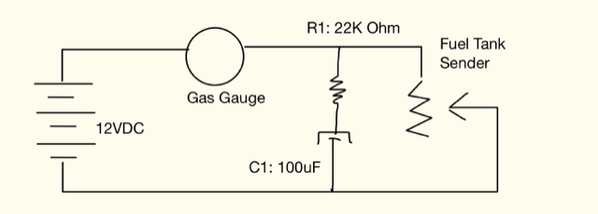OK, MAJOR BREAKTHROUGH TIME!!!!!!!!!!!!!
I sat down and started playing with the formula for an R/C circuit (resistance/capacitance) and quickly needed the assistance of my Engineer wife who came up with a spiffy little calculated circuit calling for a 22K resistor and a 100µf electrolytic cap. Trust me, you do not want to see the formulae she used, although she seemed pretty comfortable with them - I’m not ![]()
The circuit looks like this:
That’s the good news. The bad news is that I don’t have a 100µf cap in stock (this ain’t “Radio Shack”, after all....) All I could find was a 50µf which, from her calcs, will give me a faster full charge time but about 50% less of a dampening effect. In other words, instead of averaging over 5 - 10 seconds, it averages over 2 - 5 seconds. Well, Howdy. What’s that gonna look like?
So the next step was to turn Pearl in to a lab mule and play with the parts I have on hand, putting it together with alligator clip wires. And the road test results are.........
Exactly what my senior lab assistant’s calculations showed they would be; The needle still moves, but over the same section of road (same direction) the needle moves about 1/2 of what it does without the damping circuit installed - about 3-4 needle widths above and below the average (as opposed to +/- half a tank before!) The calcs say going to the larger cap should pull that in to within +/- 2 needle widths as it averages (charges/discharges the larger cap) over a longer period.
So, there you have it. I still don’t know how the heck that VW vi brator works, nor do I wish to find out.
You want to reduce the jumpy needle in your VDO-style 356 gas gauge? Get a 22K 1/2 watt resistor and a 100 µf electrolytic cap and wire them in per the diagram above. Battery “+” is at the top, “+” side of the capacitor is UP, battery ground is at the bottom and the cap’s “-“ end is grounded. It makes no electrical difference whether they are connected at the gauge end or sender end, whichever is easier to install and can be insulated easier.



